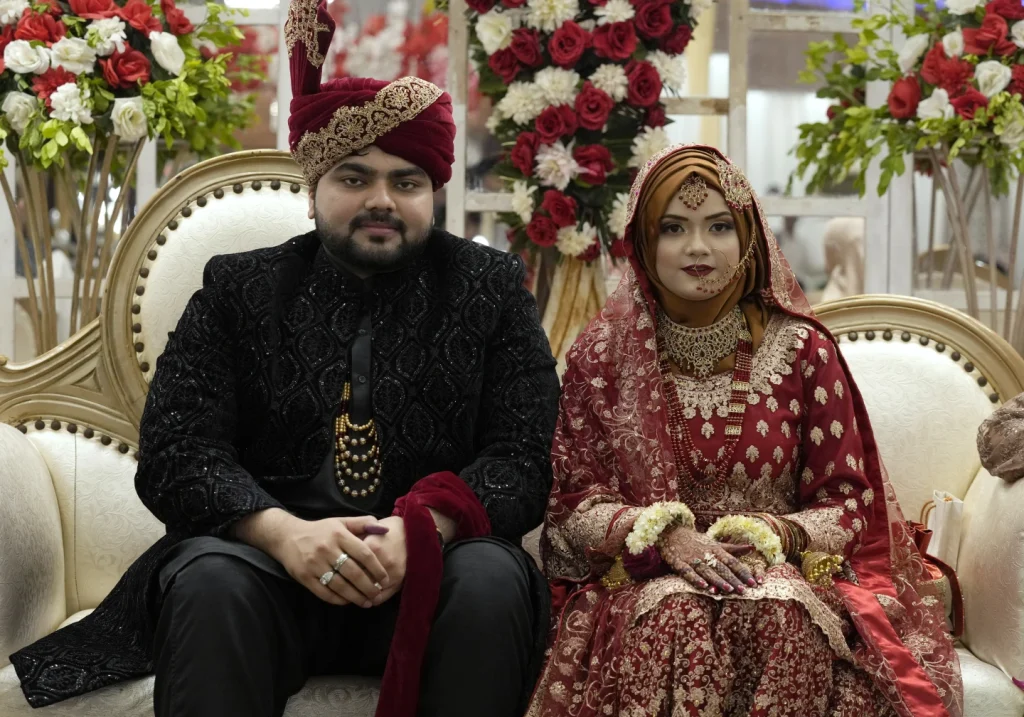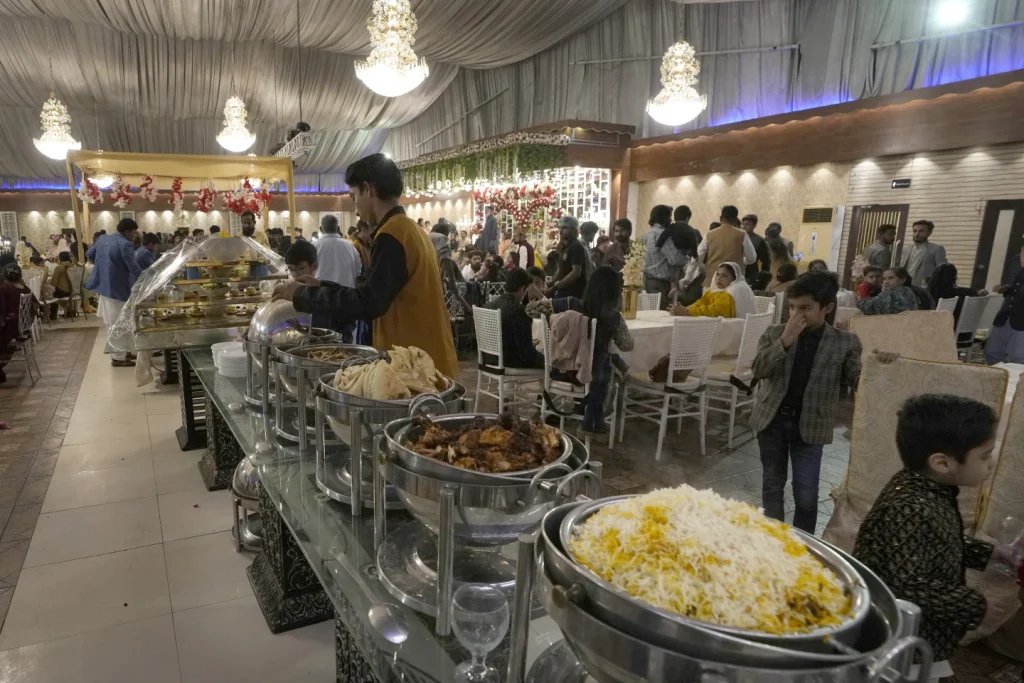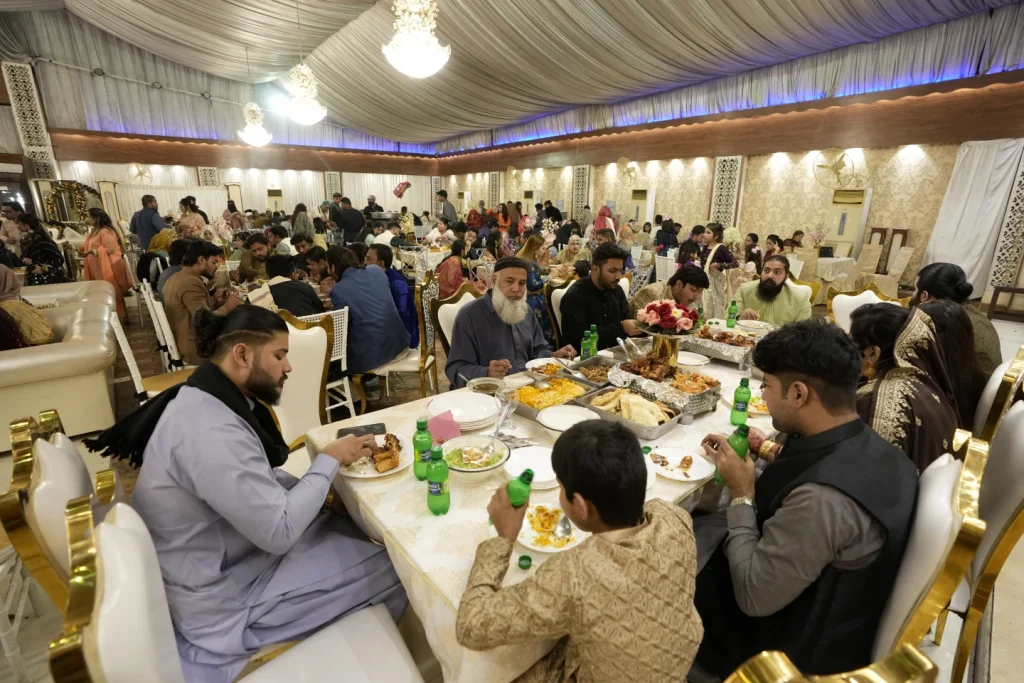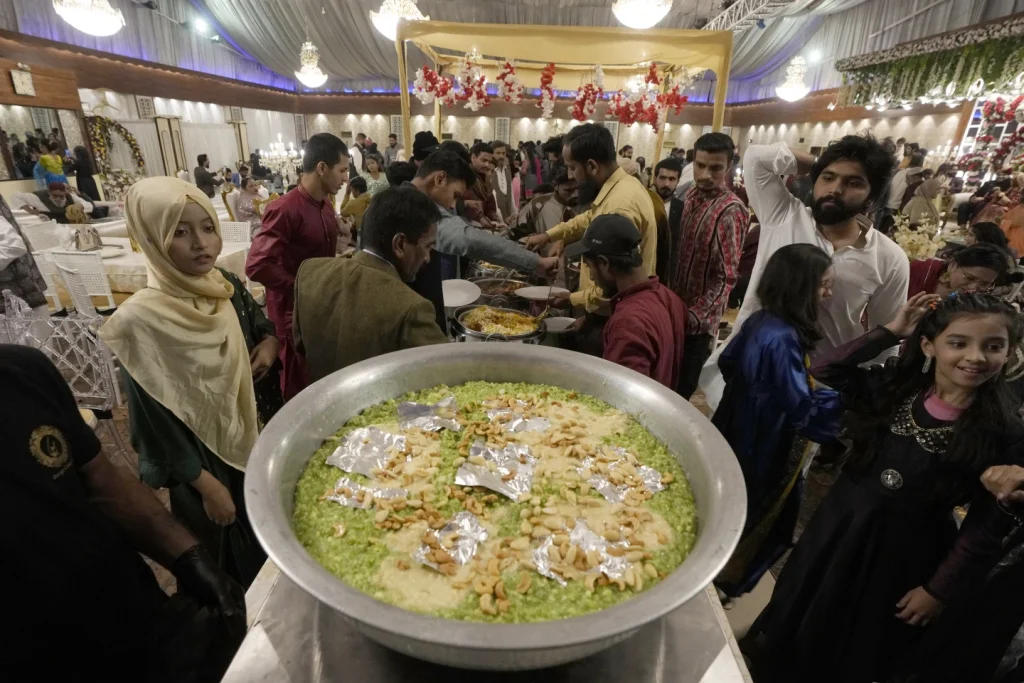The cultural tapestry of Pakistan is woven with vibrant threads of tradition, celebration, and festivity, and at the heart of this tapestry lies the grandeur and magnificence of Pakistani weddings.
The bustling city of Karachi, Pakistan, serves as a microcosm of this exuberant celebration, where the air is filled with the harmonious blend of joyous melodies, the tantalizing aroma of biryani and chicken tikka, and the resplendent sight of bejeweled brides and natty grooms.
As the winter season descends upon Pakistan, it heralds the onset of an extraordinary phenomenon – the proliferation of weddings.
This period, spanning from November to February, witnesses a crescendo of matrimonial ceremonies, drawing millions of people into a whirlwind of jubilation and merriment.
The allure of December in Pakistan is so profound that it has earned the endearing moniker “Decemberistan,” signifying a time when worries are momentarily set aside, and the populace unites in a collective embrace of the present moment.
The essence of a Pakistani wedding is not confined to a singular event but unfolds as a series of enchanting celebrations.
From the engagement ceremony to the application of turmeric paste and henna, each ritual is steeped in tradition, accompanied by the rhythmic cadence of music and dance.
The procession of the bride and groom further embellishes the spectacle, weaving a narrative of love, tradition, and familial bonds.
In the heart of Karachi’s Cantonment area, the union of Yamima Teresa Bhagtaney and Sharoon Arjumand John at the Holy Trinity Cathedral exemplified the confluence of Christian and Pakistani wedding customs.
The amalgamation of a traditional Christian wedding, complete with hymns, vows, and the exchange of rings, with the vibrant exuberance of Pakistani ceremonies, encapsulates the rich diversity and inclusivity inherent in the fabric of Pakistani society.
The evolution of Pakistani weddings is emblematic of an enduring tradition embracing modernity, as evidenced by the increasing opulence and grandeur that adorn these celebrations.
The meticulous documentation of every detail through the lens of multiple photographers and videographers reflects the desire to immortalize the splendor of these moments, preserving them for posterity.

The significance of Pakistani weddings extends beyond mere revelry; it serves as a vital conduit for socialization and communal bonding in a conservative Muslim society.
These matrimonial extravaganzas provide an invaluable opportunity for individuals to transcend societal barriers, fostering an environment of unity and camaraderie.
The resplendent tapestry of Pakistani weddings continues to captivate the imagination, weaving together the threads of tradition, modernity, and inclusivity.
As the allure of Decemberistan beckons, it serves as a testament to the enduring spirit of celebration, love, and togetherness that defines the essence of Pakistani weddings.
Munir’s observation regarding the emphasis on attire and social media presence sheds light on the evolving nature of weddings.
The significance placed on external appearances and the pressure to conform to societal expectations have transformed these events into showcases of materialism and social status.
The proliferation of social media has further amplified these trends, with individuals often prioritizing the display of their outfits and experiences over genuine emotional connections.
This shift raises compelling questions about the true purpose of weddings and the values they should embody.
The escalating costs associated with modern weddings present a stark contrast to the economic realities faced by many.
The staggering expenses involved in hosting such events, as exemplified by the million-rupee price tag for a banquet hall, underscore the disparity between ostentatious celebrations and the economic challenges prevalent in the region.
The juxtaposition of exorbitant wedding costs against a backdrop of economic constraints and inflation prompts a critical examination of societal priorities and financial prudence.
The availability of wedding financing options and support from welfare institutions reflects the intricate interplay between tradition, social expectations, and economic realities.
While these avenues alleviate some of the financial burdens, they also underscore the societal significance attributed to weddings and the communal support structures in place.
The dichotomy between the extravagant nature of weddings and the financial strain they impose on families underscores the complex tapestry of cultural norms and economic pressures.
Despite the financial strain and sartorial demands associated with the wedding season, individuals like Dua express a deep-rooted appreciation for the communal spirit and celebratory atmosphere that permeate these events.
The enduring allure of the wedding season, despite its financial implications, speaks to the profound cultural significance attached to these celebrations.
Dua’s sentiment encapsulates the dichotomy between the tangible challenges posed by the wedding season and the intangible sense of joy and togetherness it fosters.
The evolving dynamics of wedding ceremonies are not confined to urban centers alone, as Fizza Bangash’s experiences in Islamabad illuminate the multifaceted nature of these celebrations.
The confluence of cultural traditions, societal expectations, and global influences is palpable in her account of hosting a wedding with international guests.

The interplay of global connections and local customs underscores the evolving nature of weddings as they navigate the intersection of tradition and modernity.
The transformation of wedding venues and the emergence of new trends in event management underscore the evolving demands and preferences of contemporary couples.
The proliferation of opulent venues and the advent of live cooking stations reflect a departure from traditional practices, signaling a shift towards immersive and experiential celebrations.
However, amidst these modern developments, echoes of simpler times resonate in Bangash’s recollections of intimate, homespun weddings, underscoring the enduring value of familial connections and heartfelt gatherings.
The contrast between lavish wedding venues and the simplicity of traditional celebrations is further exemplified by the account of a makeshift wedding in Karachi.
The absence of opulence and the reliance on makeshift arrangements paint a poignant picture of the resilience and adaptability exhibited amidst challenging circumstances.
This portrayal serves as a reminder of the intrinsic significance of weddings, transcending material extravagance and illuminating the resilience and spirit of communities.
In conclusion, the contemporary wedding landscape reflects a complex interplay of societal expectations, economic constraints, and evolving cultural dynamics.
The juxtaposition of opulence and simplicity, global influences and local traditions, underscores the multifaceted nature of these celebrations.
As we navigate the changing contours of weddings, it is imperative to preserve the intrinsic values of unity, joy, and communal bonds that transcend material trappings.
By embracing the evolving landscape of weddings while cherishing timeless values, we can navigate this cultural tapestry with grace, reverence, and an appreciation for the diverse threads that weave it together.
The evolving dynamics of wedding ceremonies are not confined to urban centers alone, as Fizza Bangash’s experiences in Islamabad illuminate the multifaceted nature of these celebrations.
The confluence of cultural traditions, societal expectations, and global influences is palpable in her account of hosting a wedding with international guests.
The interplay of global connections and local customs underscores the evolving nature of weddings as they navigate the intersection of tradition and modernity.
The transformation of wedding venues and the emergence of new trends in event management underscore the evolving demands and preferences of contemporary couples.
The proliferation of opulent venues and the advent of live cooking stations reflect a departure from traditional practices, signaling a shift towards immersive and experiential celebrations.
However, amidst these modern developments, echoes of simpler times resonate in Bangash’s recollections of intimate, homespun weddings, underscoring the enduring value of familial connections and heartfelt gatherings.
The contrast between lavish wedding venues and the simplicity of traditional celebrations is further exemplified by the account of a makeshift wedding in Karachi.
The absence of opulence and the reliance on makeshift arrangements paint a poignant picture of the resilience and adaptability exhibited amidst challenging circumstances.
This portrayal serves as a reminder of the intrinsic significance of weddings, transcending material extravagance and illuminating the resilience and spirit of communities.

In conclusion, the contemporary wedding landscape reflects a complex interplay of societal expectations, economic constraints, and evolving cultural dynamics.
The juxtaposition of opulence and simplicity, global influences and local traditions, underscores the multifaceted nature of these celebrations.
As we navigate the changing contours of weddings, it is imperative to preserve the intrinsic values of unity, joy, and communal bonds that transcend material trappings.
By embracing the evolving landscape of weddings while cherishing timeless values, we can navigate this cultural tapestry with grace, reverence, and an appreciation for the diverse threads that weave it together.
